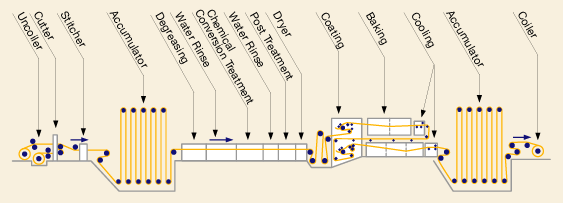

Surface Treatment
Aluminum is a metal that primarily has a beautiful surface and superior corrosion resistance. Yet various surface treatments, if applied to aluminum, further improve these characteristics or provide additional characteristics.
The typical surface treatment methods for aluminum include anodic oxide coating, coloration, coating, mechanical surface treatment, chemical film coating, bright anodic oxide coating (gloss treatment), enamel coating, and plating. In addition, new technologies have been developed including ion plating and sputtering.
Coating
The typical examples of coated aluminum include an aluminum coated plate (called colored aluminum) that is manufactured by continuously baking an aluminum coil coated with polyester, acrylic, epoxy, fluoric, or other coating material; an aluminum can that is coated before or after molding; an aluminum sash, blind, and building material of which alumite priming is coated. Among them, colored aluminum has been increasingly used for building materials such as roofs and outer walls, vehicles, and various kinds of equipment.

Surface Functional Treatment
The surface treatment for aluminum was conventionally performed mainly for improving fanciness and corrosion resistance. Recently, however, a surface functional technology has been developed to providing materials with superior functionalities in compliance with the needs of electronics and other advanced technological fields. This technology is intended to produce functional film by applying various technologies for anodic oxide coating, chemical film coating, plating, etc.
The functionalities provided by functional coating include superior characteristics such as wear and corrosion resistance, and a lubricating property, magnetization, electric conductivity, luminescence, and other properties that facilitate moving machine parts.
Anodic Oxide Coating
The anodic oxide coating of aluminum, which is also known as Alumite, is one of the technologies we boast to the world.
Aluminum is an activated metal, which naturally forms thin film of aluminum oxide as it reacts with oxide in the atmosphere. Since this aluminum oxide, once formed, will not change, it plays the role of protecting the internal aluminum. This explains why aluminum is hardly corroded in general. The oxide film that is naturally produced is very thin. In contrast, thick, strong oxide film is artificially produced by an electrochemical treatment, which is called the anodic oxide coating. In practice, an aluminum product is put in an electrolytic solution (acid solution). When low DC, AC, or AC/DC is applied with the aluminum product used as an anode, oxide film is formed on its surface. If different types, temperatures, and current densities of the electrolytic solution, different types of aluminum alloys, and other conditions are combined here, various colors such as silver, gold, umber, and black can be produced (coloring/coloration) and harder film can be made available.
The surface of oxide film has a large number of micropores (0.01 to 0.05 μm in diameter; 60 to 800 micropores per μm²). If aluminum coated with oxide film is put in a pressure vessel and pressurized by blowing steam or if it is put in boiling water to have aluminum hydroxide formed in the superficial area of its micropores, the micropores are closed making the surface smooth. This treatment is called sealing. In performing this treatment, the micropores may be colored by letting dyestuff penetrate into them.
As alumite coloration methods, there are the AC electrolytic coloring method and the natural color appearance available.
Mechanical Surface Finish
Available as mechanical surface finish methods are emboss, dull surface finish, shot blast, buffing, barrel polishing, etc. In particular, emboss is often used to finish building and decorating materials. Dull surface finish using laser is used to finish automobile door panels, etc.
Get Price , More Detail Please Contact Us !